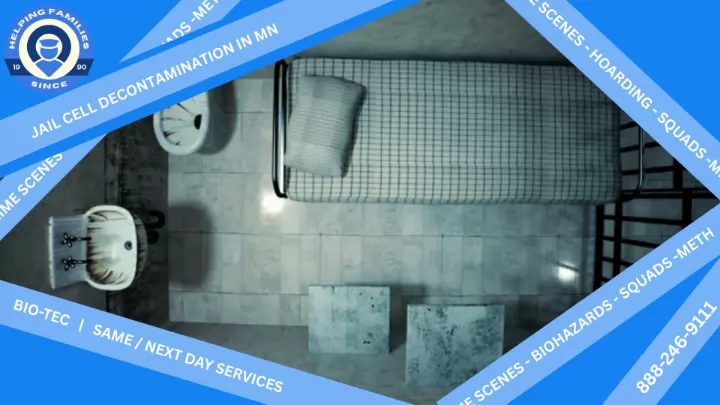How is meth testing conducted in a property?
Meth testing involves collecting samples from surfaces within the property, typically using swabs. These samples are then analyzed in a laboratory to detect the presence and concentration of methamphetamine residues.
What steps are taken when bodily fluids are found in a patrol car?
Bodily fluids are treated as biohazards, requiring removal, disinfection, and sanitization processes.
Can blood cleanup services remove odors?
Yes, professionals use advanced odor neutralizers and air purifiers to eliminate any lingering smells. This ensures the environment is fully restored and free from unpleasant reminders of the incident.
Can crime scene cleanup be done in occupied buildings?
With proper containment and safety measures, crime scene cleanup can be safely conducted in buildings that are still occupied.
What happens if hypodermic needles are lodged in hard-to-reach areas of the vehicle?
Needles are carefully removed, and all surrounding surfaces are disinfected to remove pathogens.
What are long-term decomposition odor solutions for a home?
Long-term solutions for decomposition odors in a home hinge on achieving complete removal and neutralization of the source and all affected materials, followed by comprehensive air and surface treatment. Simply masking the odor or cleaning surfaces will lead to recurrence. The foundational step is the physical removal of all decaying organic matter. This is non-negotiable. Following this, removing all porous materials that have absorbed the odor is critical. This almost always includes carpets, padding, sections of subflooring, drywall, insulation, and any contaminated furniture or textiles. These items are like sponges for decomposition odors and will off-gas the smell indefinitely if not removed and properly disposed of. After removal, thorough cleaning and disinfection of all remaining non-porous surfaces (e.g., concrete, metal, hard plastics) with professional-grade enzymatic cleaners and broad-spectrum disinfectants. This actively breaks down the odor-causing organic molecules and eliminates odor-producing bacteria. For deeply embedded odors in structural elements (like framing wood), odor-encapsulating primers or sealants are essential. These specialized coatings create a barrier that prevents residual odor molecules from leaching out into the air. Finally, atmospheric treatment with professional equipment like ozone generators or hydroxyl generators is necessary to neutralize any lingering airborne odor molecules or those absorbed into materials that cannot be removed. These machines may need to run for extended periods. Post-remediation air quality testing can verify the absence of harmful compounds and odors. Maintaining good ventilation, managing indoor humidity, and preventing future sources of decomposition (e.g., pest control, immediate spill cleanup) are crucial long-term preventative measures. For severe or persistent odors, professional remediation ensures these steps are carried out thoroughly and safely for a permanent solution.
Is specialized equipment used for interior biohazard cleaning?
Yes, advanced tools like industrial-grade vacuums, steam cleaners, and bio-scanners are routinely used.
What documentation is typically provided after cleanup?
Detailed reports, photographs, and certificates of decontamination are provided for regulatory compliance and insurance purposes.
Can tear gas residue affect food and water?
Yes, tear gas residue can contaminate food and water sources, posing health risks. Professional cleanup ensures that all affected items are safely removed and disposed of.
What is professional hoarding cleanup?
Professional hoarding cleanup is a specialized service that helps individuals with hoarding disorder or extreme clutter restore their living spaces to a safe, functional, and sanitary condition. Unlike regular cleaning services, hoarding cleanup professionals are trained to handle hazardous materials, biohazards, mold, pest infestations, and excessive clutter with care and discretion. These services also provide emotional support and work with mental health professionals when needed to ensure a compassionate and structured approach. The cleanup process typically includes assessment, sorting, organizing, deep cleaning, and sanitization. Many professional hoarding cleanup companies also offer follow-up support to help individuals maintain a clutter-free environment in the long run.
